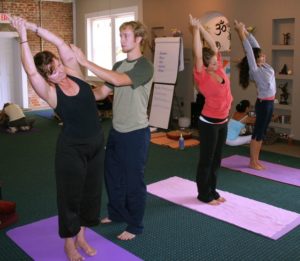Improve Cardiovascular Health in Postmenopausal Women with Yoga
By John M. de Castro, Ph.D.
“Yoga is designed to bring about increased physical, mental and emotional well-being. Hand in hand with leading a heart-healthy lifestyle, it really is possible for a yoga-based model to help prevent or reverse heart disease. It may not completely reverse it, but you will definitely see benefits.” –M. Mala Cunningham
Yoga practice has been shown to have a large number of beneficial effects on the psychological, emotional, and physical health of the individual and is helpful in the treatment of mental and physical illness, including cardiovascular disease and metabolic problems. This is important as cardiovascular disease is the number one killer, claiming more lives than all forms of cancer combined. There are a large number of risk factors that increase the likelihood of heart disease. Menopause and the consequent drop in Estrogen levels is just such a risk factor that greatly increases the likelihood of heart disease in postmenopausal women.
The safest effective preventative techniques for heart disease are lifestyle changes. These include quitting smoking, weight reduction, improved diet, physical activity, and reducing stresses. Other safe and effective treatments are contemplative practices, such as meditation, tai chi, and yoga, have also been shown to be helpful for heart health. These practices have also been shown to be helpful for producing the kinds of lifestyle changes needed to prevent heart disease such as smoking cessation, weight reduction, and stress reduction. Since, yoga is a mindfulness practice and an exercise it would seem to be ideally suited for the prevention of cardiovascular problems.
In today’s Research News article “Yoga offers cardiovascular protection in early postmenopausal women.” (See summary below or view the full text of the study at: http://www.ijoy.org.in/article.asp?issn=0973-6131;year=2018;volume=11;issue=1;spage=37;epage=43;aulast=Praveena ), Praveena and colleagues examine the ability of yoga practice to improve cardiovascular function in postmenopausal women. They recruited women between 45 and 60 years of age who were within 5 years of menopause and assigned them to treatment as usual or to practice yoga for 12 weeks, 1-hour per day, 6 days per week. They were trained for a week and then assigned to practice at home. Yoga practice included poses, breathing practices, chanting, and relaxation. They were measured before and after the 12-week practice for body size and cardiac function, as measured with electrocardiogram (ECG).
They found that the treatment as usual group had significant increases in electrocardiogram (ECG) low frequency signal that reflect increased sympathetic nervous system activity while having decreased high frequency ECG activity that reflect decreased parasympathetic nervous system activity. This signifies that the control group had significantly increased cardiovascular activation. On the other hand, the yoga group had significant decreases in electrocardiogram (ECG) low frequency signal that reflect decreased sympathetic nervous system activity while having increased high frequency ECG activity that reflect increased parasympathetic nervous system activity. This signifies that yoga practice significantly decreased cardiovascular activation.
The results suggest that yoga practice relaxes the cardiovascular system in postmenopausal women. This is a positive sign for these women who have increased risk of cardiovascular disease and may suggest that if they continue yoga practice in the future they will have improved cardiovascular health. Yoga practice is “a safe, natural, nonpharmacological technique with low implementation cost, ease of adoption by a broad range of population, high perceived satisfaction quotient, psychological benefits, and good compliance.” This suggests that yoga practice may be an almost ideal treatment for improving cardiovascular health in postmenopausal women.
So, improve cardiovascular health in postmenopausal women with Yoga.
“Over all, people who took yoga classes saw improvements in a number of factors that affect heart disease risk. They lost an average of five pounds, shaved five points off their blood pressure, and lowered their levels of harmful LDL cholesterol by 12 points.” – Judy Corliss
CMCS – Center for Mindfulness and Contemplative Studies
This and other Contemplative Studies posts are also available on Google+ https://plus.google.com/106784388191201299496/posts and on Twitter @MindfulResearch
Study Summary
Praveena SM, Asha G, Sunita M, Anju J, Ratna B. Yoga offers cardiovascular protection in early postmenopausal women. Int J Yoga 2018;11:37-43
Abstract
Context: Postmenopause, an estrogen deficient state comes with increased incidence of cardiovascular diseases (CVDs). Yoga has been described as having a beneficial effect on heart rate variability (HRV), a marker for cardiac autonomic activity which can assess cardiovascular risk, in various populations. Aim: the aim of the study was to study the effect of 3-month long Yoga practice on HRV in early postmenopausal women. Settings and Design: A prospective longitudinal study of 67 women within 5 years of menopause between 45 and 60 years of age attending menopause clinic of Department of Gynaecology, Sucheta Kriplani Hospital fulfilling inclusion and exclusion criteria and consenting were enrolled for the study. Subjects and Methods: HRV of 37 cases (Yoga group) and 30 controls (non-Yoga group) was recorded pre and 3-month postintervention. Statistical Analysis Used: GraphPad Prism Version 5 software was used. Values are a mean and standard error of mean. Statistical significance was set up at P < 0.05.
Results: In HRV, frequency domain analysis showed a significant fall in low frequency (LF) in normalized units (nu) and LF: high frequency (HF) ratio and significant rise in HF in nu in the Yoga group (depicting parasympathetic dominance) against a significant rise in LF (nu) and LF: HF ratio and significant fall in HF (nu) in non-Yoga group (indicating sympathetic dominance). Time domain analysis showed a significant decrease in Standard Deviation of NN intervals in Non-Yoga group against nonsignificant changes in Yoga group indicating deterioration in parasympathetic activity in non-Yoga group. Conclusions: Three-month long Yoga practice improved HRV in early postmenopausal women significantly and has the potential to attenuate the CVD risk in postmenopausal women.

2 thoughts on “Improve Cardiovascular Health in Postmenopausal Women with Yoga”